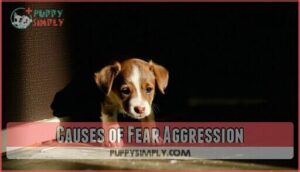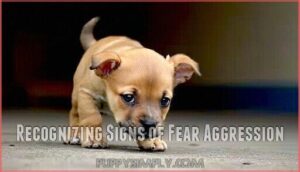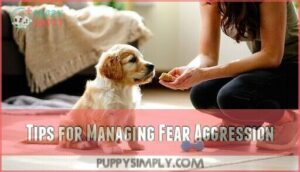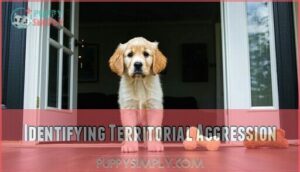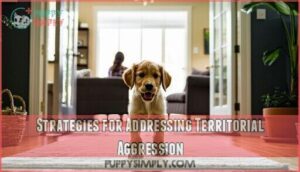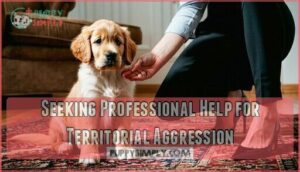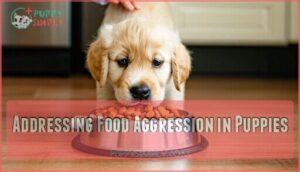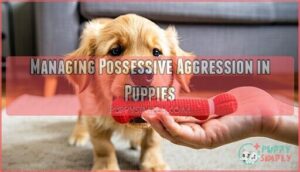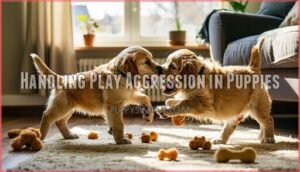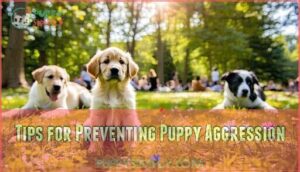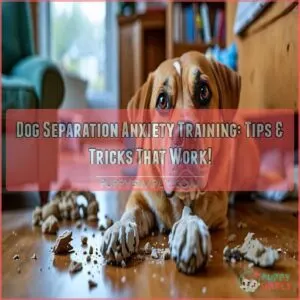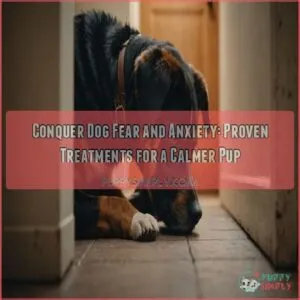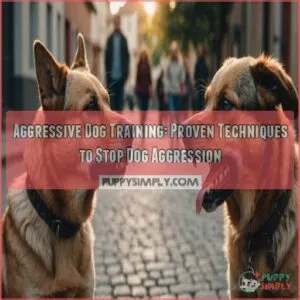This site is supported by our readers. We may earn a commission, at no cost to you, if you purchase through links.
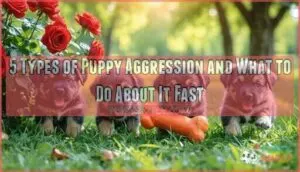
Each type stems from different triggers and requires specific approaches.
Fear aggression needs gentle confidence-building, while territorial behavior requires consistent boundaries.
Food aggression responds well to trading games and positive associations during meals.
Possessive aggression benefits from teaching "drop it" commands early.
Play aggression simply needs redirection to appropriate outlets.
The key is recognizing these patterns early, since what seems like harmless puppy antics can escalate quickly without proper intervention and guidance.
Table Of Contents
- Key Takeaways
- Types of Puppy Aggression
- Understanding Fear Aggression in Puppies
- Dealing With Territorial Aggression in Puppies
- Addressing Food Aggression in Puppies
- Managing Possessive Aggression in Puppies
- Handling Play Aggression in Puppies
- Seeking Professional Help for Puppy Aggression
- Importance of Early Intervention for Puppy Aggression
- Tips for Preventing Puppy Aggression
- Frequently Asked Questions (FAQs)
- Can a puppy be aggressive?
- How to stop aggressive behavior in puppies?
- How do you know if a puppy is aggressive?
- What can help prevent aggression in puppies?
- Can a vet help a puppy become aggressive?
- Is Puppy aggression a breed-specific problem?
- How do I stop aggression in my puppy?
- Can aggression be trained out of a puppy?
- How to punish a puppy for being aggressive?
- Can puppies grow out of aggression?
- Conclusion
Key Takeaways
- Early intervention is crucial – You cannot wait and hope puppy aggression resolves itself; addressing these behaviors immediately prevents them from becoming ingrained patterns that are much harder to correct later.
- Each aggression type requires specific strategies – You will need different approaches for fear-based reactions (confidence-building), territorial behavior (boundary setting), food aggression (trading games), possessive behavior (drop-it commands), and play aggression (redirection).
- Positive reinforcement works better than punishment – You should focus on rewarding calm behavior and teaching alternative responses rather than punishing aggressive actions, which often escalates fear and worsens the problem.
- Professional help isn’t failure – You need to recognize when aggression exceeds your training abilities and seek veterinary or behaviorist assistance, especially when safety becomes a concern or multiple aggression types are present.
Types of Puppy Aggression
Understanding different types of puppy aggression helps you address behavioral issues before they become serious problems.
Recognizing these five main types allows you to respond appropriately and create a safer environment for everyone in your home, by understanding puppy aggression.
Fear Aggression
When does fear aggression rear its head in your puppy’s behavior? This common form of puppy aggression emerges when your pup feels cornered or threatened, triggering defensive responses to create distance from perceived dangers.
Fear aggression develops when puppies haven’t received proper puppy socialization or face overwhelming aggression triggers. Your puppy’s body language speaks volumes—watch for these calming signals:
Looking at this content about puppy aggression, I’ll create a short, engaging blockquote that matches the informative yet accessible tone:
**Your puppy’s body language is their first language—learn to read the signs before they escalate.
- Pinned-back ears and tucked tail position
- Darting eyes that avoid direct contact
- Stiff body posture with hackles raised
- Backing away while maintaining visual contact
Effective aggression management starts with trigger identification and creating safe spaces where your puppy feels secure. Anxiety management through gradual exposure helps build confidence. Use socialization techniques that expose your pup to new experiences at their comfort level. Remember, rushing the process often backfires—patience pays off when addressing fear-based responses in young dogs.
Territorial Aggression
Unlike fear-based reactions, territorial aggression emerges when your puppy views strangers as potential threats to their space.
This protective instinct kicks in when unfamiliar people enter your home or yard.
| Trigger | Signs | Management |
|---|---|---|
| Strangers at door | Barking, hackles raised | Boundary setting, controlled introductions |
| New pets | Blocking access, growling | Gradual socialization, supervised meetings |
| Yard intrusions | Fence running, lunging | Intruder identification training, redirection |
Defining territory comes naturally to puppies, but you’ll need management techniques to shape this behavior properly.
Watch for territorial body language like stiff posture and direct staring.
Some breeds show stronger territorial tendencies than others.
Prevention strategies include early puppy training that teaches appropriate responses to visitors.
You can redirect this energy through structured socialization rather than punishment.
Remember, your pup isn’t being "bad" – they’re trying to protect what matters to them.
Food Aggression
Food aggression develops when puppies guard their meals and become defensive around their food bowl. This behavior stems from natural instincts but can escalate into serious possessive aggression if left unchecked.
Food guarding is instinct, but unchecked aggression becomes a serious problem.
You’ll notice signs like stiff posture, direct staring, or growling when someone approaches during feeding time. Creating a calm feeding environment helps prevent these issues from developing. Establishing Food Bowl Control through consistent routines builds trust and reduces anxiety around mealtime.
Here’s how to address food aggression effectively:
- Practice Desensitization Training by gradually approaching your puppy while they eat, rewarding calm behavior
- Build Positive Associations by adding treats to their bowl while they’re eating
- Implement Safe Feeding Practices like feeding in quiet areas away from distractions
- Focus on Preventing Escalation by teaching "wait" and "leave it" commands before meals
Resource guarding behaviors respond well to patient, consistent training. Never punish or forcefully remove food, as this increases anxiety. Instead, trade something valuable for the guarded item. Professional guidance becomes necessary when aggressive responses intensify or persist despite consistent training efforts, which can help in addressing food aggression effectively.
Possessive Aggression
Your puppy’s possessive aggression shows when they guard toys, beds, or other valued items through growling and snapping.
This resource guarding behavior stems from your pup viewing certain objects as high-value treasures worth defending.
Start with Trigger Identification by noting which items cause guarding behaviors.
Use Object Exchange techniques where you trade a guarded item for something equally appealing.
Safe Handling means never forcefully taking possessions away, which escalates aggression.
Implement Gradual Desensitization by approaching slowly while offering treats.
This puppy aggression requires patience and consistent training to modify object guarding tendencies safely.
Play Aggression
One moment your puppy’s wrestling with their favorite toy, the next they’re treating your ankle like a chew bone. Play aggression in puppies involves biting, growling, and pouncing during what starts as innocent fun. This behavior stems from natural instincts but needs proper guidance to prevent escalation.
You’ll recognize play aggression when your pup gets overly excited during games, nips at hands or feet, or won’t calm down when play ends. The key difference? True aggression involves rigid body language and intense staring, while play aggression comes with loose, bouncy movements.
Teaching bite inhibition helps puppies learn appropriate pressure during play. When they bite too hard, immediately stop the game and walk away. This teaches consequences for rough behavior.
Redirecting energy toward appropriate toys gives puppies acceptable outlets for their playful nature. Provide plenty of mental stimulation through puzzle toys and training exercises. Socialization skills develop through supervised interactions with other dogs, helping puppies learn play boundaries naturally.
Set clear play boundaries by ending games before excitement peaks. Consistency prevents puppy play behavior from becoming problematic puppy aggression.
Understanding Fear Aggression in Puppies
Fear aggression happens when your puppy feels scared or overwhelmed and uses aggressive behavior to create distance from what frightens them.
This type of aggression affects nearly half of all dogs and typically shows up when puppies encounter loud noises, unfamiliar people, or new environments they can’t escape from, which can lead to fear.
Causes of Fear Aggression
Fear aggression stems from multiple root causes that shape your puppy’s behavior.
Genetic predisposition plays a significant role, with certain breeds showing higher anxiety disorders.
Lack socialization during critical early experiences creates lasting fear responses.
Environmental triggers like loud noises or unfamiliar people can spark puppy aggression, including puppy biting, puppy nipping, and puppy growling.
Traumatic events or improper handling amplify these reactions, making fear aggression a complex behavioral challenge requiring immediate attention.
Some pups benefit from desensitization and counterconditioning to address these fear responses and anxieties, which can lead to puppy aggression and require immediate attention to prevent further issues.
Recognizing Signs of Fear Aggression
Watch for these telltale signs that reveal your puppy’s inner anxiety.
Subtle Fear Signals include pinned-back ears, a tucked tail, and darting eyes that avoid direct contact.
Your pup might also yawn excessively or lick their lips when they’re not tired or thirsty.
Body Language Cues show a crouched posture, with your puppy making themselves appear smaller.
They’ll often freeze completely or slink away from whatever’s causing stress.
Environmental Triggers can spark these reactions – loud noises, unfamiliar people, or new locations often overwhelm young dogs.
Avoidance Behaviors become obvious when your puppy consistently hides behind you or refuses to approach certain situations.
Understanding their Reactivity Thresholds helps you spot when fear aggression might escalate.
Puppy growling or puppy biting often follows these warning signs if the stress continues.
Learning to read puppy body language prevents minor fears from becoming major behavioral problems that require intensive intervention later.
Tips for Managing Fear Aggression
After recognizing the warning signs, you can take practical steps to help your puppy overcome fear aggression through proven behavior modification techniques.
Managing this challenge involves patience and the right approach.
Here are three effective Socialization Methods and Anxiety Management strategies:
- Gradual exposure training – Slowly introduce your puppy to fear triggers at a comfortable distance, rewarding calm behavior with treats
- Counter-conditioning exercises – Pair scary situations with positive experiences like favorite toys or Reward Training sessions
- Environmental management – Create safe spaces where your puppy can retreat when feeling overwhelmed
Calming Techniques like deep pressure therapy and Behavioral Conditioning help reduce stress responses.
Consistent socialization prevents puppy biting incidents and builds confidence.
Remember that fear aggression often stems from lack of early exposure, so gentle persistence with these methods typically shows improvement within weeks.
Dealing With Territorial Aggression in Puppies
Territorial aggression shows up when your puppy views strangers or visitors as threats to their space and responds with barking, growling, or defensive posturing.
You’ll need to work on controlled socialization and teach your puppy that new people aren’t invaders but welcome guests, which can help address territorial aggression.
Identifying Territorial Aggression
While fear aggression stems from anxiety, territorial aggression emerges when your puppy feels their space is being invaded.
Spotting these defensive postures early helps prevent escalation and keeps everyone safe.
Your puppy’s body language tells the whole story.
Environmental factors like doorways, food bowls, or favorite sleeping spots often trigger territorial responses.
Early warning signs include stiff posturing, direct staring, and barrier-seeking behavior.
| Warning Sign | What It Means |
|---|---|
| Stiff body posture with raised hackles | Your puppy’s claiming ownership of space |
| Blocking doorways or pathways | Defensive positioning against perceived intruders |
| Growling when approached near resources | Boundary setting through vocal warnings |
| Freezing when strangers approach territory | Trigger identification moment requiring immediate attention |
Boundary setting becomes your puppy’s primary defense mechanism.
Dog territoriality develops naturally, but aggression prevention requires recognizing these patterns.
Watch for defensive postures during visitor arrivals or when other pets approach your puppy’s claimed areas.
Strategies for Addressing Territorial Aggression
Start by establishing clear boundaries around your home’s entry points and spaces where territorial aggression occurs.
Identify specific triggers like doorbell sounds or unfamiliar visitors that spark your puppy’s defensive behavior.
Use behavioral conditioning with positive reinforcement to reward calm responses when these triggers appear.
Practice socialization techniques by gradually exposing your puppy to new people in controlled settings.
Learn to read your puppy’s body language – stiff posture and direct stares signal mounting tension.
Redirect territorial displays before they escalate into full aggression episodes, using positive reinforcement to encourage calm behavior.
Seeking Professional Help for Territorial Aggression
Don’t tackle territorial aggression alone when your puppy’s behavior escalates beyond basic training. Professional help provides the expertise needed for lasting solutions.
Consider these professional options:
- Vet assessment rules out medical causes and explores medication options if needed
- Certified dog trainer teaches proven behavior modification and training techniques
- Animal behaviorist creates personalized long-term management plans for complex cases
- Early intervention prevents territorial aggression from becoming deeply ingrained puppy aggression patterns
To address this, consider desensitization strategies for lasting impact.
Addressing Food Aggression in Puppies
Food aggression happens when your puppy guards their bowl by growling, stiffening, or snapping at anyone who comes near during mealtime.
This protective behavior stems from natural instincts but needs immediate attention to prevent it from becoming a serious problem as your dog grows.
Signs of Food Aggression
Your puppy’s body language speaks volumes about their relationship with food. Watch for a stiff posture when they approach their bowl – this rigid stance signals potential trouble ahead.
You’ll notice their eyes lock onto their food with a direct stare that feels intense and unwavering. Growling signs often accompany these visual cues. Your puppy might emit low, warning growls while eating or when you approach during mealtime.
This possessive behavior extends beyond just growling – some puppies will hover protectively over their bowls, blocking access with their bodies. Resource guarding behaviors can escalate quickly.
Your puppy might snap or lunge if they perceive any threat to their food source. They’ll guard their feeding environment like a fortress, treating anyone who comes near as an intruder. Recognizing underlying fear triggers can help in understanding these reactions.
These possessive aggression patterns develop early, making quick identification vital for preventing more serious food aggression issues down the road.
Training Techniques for Food Aggression
Effective training techniques for food aggression start with gradual bowl desensitization. This systematic approach reduces resource guarding behaviors by up to 60% when practiced consistently over four weeks.
You’ll begin by standing at a distance from your puppy’s food bowl, slowly moving closer during meals as your puppy remains calm. Hand feeding creates positive associations with human presence during mealtime.
Trade games teach your puppy to exchange food willingly for high-value treats, building trust rather than defensiveness. For effective training, consider using specialized food products. These behavior modification techniques work best in a calm environment with short, daily sessions.
Key training strategies include:
- Start with distance training – Stand far from the bowl initially, rewarding calm behavior before gradually moving closer
- Use high-value rewards – Offer special treats when approaching the food area to create positive associations
- Practice resource trading – Teach "give" and "drop it" commands using treat exchanges rather than forceful removal
Professional guidance increases success rates by 80% for persistent cases.
Creating a Positive Feeding Environment
Building a safe feeding space helps prevent puppy aggression before it starts. Your goal is creating positive associations with mealtime through a predictable routine that reduces food anxiety.
Feed your puppy in the same quiet spot daily. This consistency helps them understand that food comes regularly, which decreases possessive aggression. Keep the area calm – no loud noises or foot traffic during meals.
Start with gradual changes if your puppy already shows food aggression. Place their bowl down and step back several feet. As they relax, you can slowly decrease the distance over time.
Practice resource exchange during non-meal times. Trade toys or treats using commands like "drop it" or "leave it." This teaches your puppy that giving up items leads to good things, not loss.
Watch for stiff body language, direct staring, or growling around the feeding environment. These warning signs mean you need to slow down your approach and give more space.
Maintain this structured feeding environment consistently to build trust and reduce anxiety around food. This approach helps in creating a predictable routine that is essential for your puppy’s well-being.
Managing Possessive Aggression in Puppies
Possessive aggression occurs when your puppy guards toys, beds, or other valued items by growling, snapping, or blocking access.
You can manage this behavior by teaching trade commands and creating positive associations with sharing rather than taking items away forcefully, which helps in reducing possessive aggression.
Recognizing Possessive Aggression
When food aggression becomes manageable, your next challenge involves spotting possessive aggression before it escalates. This behavior centers around guarding objects your puppy considers valuable – toys, bones, beds, or even you.
Watch for these warning signs: stiff body posture when someone approaches their possessions, direct staring, low growling, or resource hoarding. Your puppy might also block access to items or snap when you reach for something they’re protecting.
These behaviors show your pup views certain items as high resource value worth defending. Possessive behavior often starts subtly. You’ll notice your puppy becoming tense around favorite toys or food bowls.
They might freeze when you approach or give you "whale eye" – showing the whites of their eyes while keeping their head still. Understanding these early signals helps you avoid triggers that escalate possessive aggression.
Rather than forcing interactions, you can begin working on teaching trade and developing healthy sharing habits. This foundation prevents minor guarding behaviors from becoming serious puppy aggression issues that require intensive intervention.
Teaching Proper Sharing and Trade
Trade games work like magic for managing possessive aggression in your puppy. These simple exercises teach your pup that giving up items leads to good things happening. Start by offering something your puppy values equally or more when you need their toy back.
Here’s your step-by-step approach:
- Begin with low-value items – Practice trade training with less exciting toys before moving to favorites
- Use positive swaps – Always exchange for something equally appealing, never just take away
- Implement gradual introduction – Slowly work up to high-value resources like special chew toys
- Practice toy rotation – Regular switching keeps possessive behavior from developing
Resource value matters tremendously. To make the trade even more enticing, consider using high quality incentives. Your puppy needs to see trades as wins, not losses.
Keep sessions short and sweet – about five minutes works perfectly. Consistency builds trust faster than anything else. When your pup willingly drops their toy, immediately reward with praise and the promised trade item. This positive approach prevents the fear-based responses that often worsen possessive aggression.
Avoiding Triggers for Possessive Aggression
Preventing possessive aggression starts with recognizing what sets your puppy off. Most pups get defensive over high-value items like favorite toys, bones, or their food bowl.
You can’t eliminate every trigger, but you can manage them smartly. Create safe spaces where your puppy can enjoy special items without interruption. This reduces their need to guard resources.
Try resource rotation by switching out toys regularly – when everything isn’t available all the time, nothing becomes precious enough to fight over. Gradual desensitization works wonders.
Start by walking past your puppy while they’re eating, then gradually move closer over days or weeks. Build positive associations by dropping extra treats in their bowl as you approach. This teaches them that humans approaching means good things happen.
Establish predictable routines around feeding and play. When your puppy knows what to expect and when, they’re less likely to feel threatened. Consistency in your feeding environment helps prevent food aggression from developing in the first place.
Handling Play Aggression in Puppies
Play aggression happens when your puppy gets too excited during games and starts biting, growling, or pouncing harder than they should.
You’ll need to teach them the difference between fun play and rough behavior that can hurt people or other pets, which is a key part of addressing play aggression.
Differentiating Play From Aggression
Spotting the difference between playful antics and true puppy aggression can feel like decoding a foreign language. Your pup’s body language holds all the answers. Healthy puppy play behavior includes relaxed movements, frequent pauses, and mutual engagement. Play aggression crosses the line when bite inhibition fails and social cues get ignored.
Watch for these key differences:
- Play signals – Look for play bows, bouncy movements, and open-mouthed grins versus stiff postures and direct stares
- Energy levels – Playful pups take breaks and self-regulate; aggressive ones escalate without stopping
- Body language – Relaxed ears and wagging tails signal play; pinned ears and raised hackles mean business
- Puppy biting – Gentle, inhibited mouthing during play versus hard, purposeful bites that don’t respond to yelping
- Puppy growling – High-pitched, intermittent play growls differ from deep, sustained warning growls
When puppy aggression emerges, redirect immediately to appropriate toys and end the interaction calmly.
Teaching Appropriate Play Behavior
Teaching your puppy proper play behavior starts with bite inhibition training. When your puppy bites too hard during play, yelp loudly and stop the game immediately. This mimics how littermates communicate boundaries.
Use positive reinforcement to reward gentle play behavior with treats and praise. Redirect aggressive energy toward appropriate toys instead of hands or clothing.
For appropriate chew alternatives, consider purchasing safe chew products. Focus on socialization skills by arranging supervised playdates with well-behaved dogs.
Provide mental stimulation through puzzle toys to prevent boredom-driven puppy aggression. Consistent training helps establish healthy puppy play behavior patterns early, using consistent training and promoting healthy play.
Redirecting Play Aggression
Your puppy’s wild play sessions don’t have to turn into wrestling matches. When play aggression kicks in, immediate redirection techniques work wonders.
The moment your pup starts biting or getting too rough, say "no" firmly and replace yourself with an appropriate toy. This toy substitution teaches bite inhibition while keeping the fun going.
Redirect that energy toward calm play by offering puzzle toys or chew items when excitement peaks. Practice socialization skills during controlled play dates where you can model appropriate puppy play behavior.
If your pup jumps or nips during greetings, ask them to sit before any interaction continues. Remember, consistency is key with redirection.
The more you practice these techniques, the faster your puppy learns proper play behavior and develops better impulse control around people and other dogs.
Seeking Professional Help for Puppy Aggression
Sometimes puppy aggression issues require more than basic training to resolve safely and effectively.
Knowing when to seek professional help can make the difference between successful behavior modification and a problem that escalates over time.
When to Consult a Veterinarian or Behaviorist
Red flags signal when professional help becomes essential for puppy aggression.
Contact a veterinarian or behaviorist immediately if you see severity escalation, where aggressive incidents become more frequent or intense.
Unresponsive training means your efforts aren’t working despite consistent practice.
Multiple aggressions across different situations—food, toys, strangers—indicate complex behavioral issues requiring expert assessment.
Safety concerns arise when puppy aggression threatens family members, especially children or elderly individuals.
Professional help becomes necessary when bites break skin or your puppy shows persistent resource guarding despite intervention attempts.
Veterinary consultation can rule out medical causes like pain or neurological issues triggering aggressive behavior.
A certified behaviorist develops targeted behavior modification plans, potentially including medication options for anxiety-driven aggression.
Don’t wait hoping things improve—early professional intervention prevents puppy aggression from becoming ingrained adult behavior patterns.
Benefits of Professional Guidance
Three key advantages make professional help invaluable when dealing with puppy aggression.
Expert assessment reveals underlying causes you might miss, from medical issues to environmental triggers that fuel aggressive behavior.
Veterinary consultation guarantees health problems aren’t driving the aggression, while certified behaviorists provide behavior modification strategies customized to your specific situation.
Professional help accelerates your progress substantially.
Rather than guessing what works, you’ll receive proven training techniques designed for your puppy’s particular aggression type.
This targeted approach delivers faster progress than trial-and-error methods.
Safety assurance becomes paramount when aggression escalates.
Professionals teach you how to handle situations safely while implementing long-term solutions.
They’ll create personalized strategies that address root causes, not just symptoms.
This thorough approach prevents aggression from worsening and protects both your family and your puppy from potential harm during the training process, ensuring safety assurance and professional help are key to resolving puppy aggression with expert assessment and behavior modification.
Tailored Treatment Plans for Puppy Aggression
Professional behaviorists create customized treatment plans that address your puppy’s specific aggressive triggers and needs.
These personalized approaches combine behavioral modification techniques like desensitization and counterconditioning with environmental enrichment strategies.
Your veterinarian might recommend medication options for severe cases alongside training techniques.
Family involvement guarantees everyone uses consistent methods at home.
Long-term management focuses on preventing setbacks through ongoing practice and monitoring. Each plan targets your puppy’s unique aggressive behavior patterns, whether it’s resource guarding or fear-based reactions.
This personalized approach gives you the best chance of transforming your pup into a well-adjusted, confident dog.
Importance of Early Intervention for Puppy Aggression
When you ignore aggressive behavior in puppies, you’re basically teaching them that these actions work to get what they want.
Early intervention stops aggression from becoming a permanent habit and helps your puppy develop into a well-adjusted adult dog who can handle life’s challenges with confidence.
Risks of Ignoring Aggressive Behavior
Ignoring puppy aggression won’t make it disappear.
Instead, you’re setting the stage for escalation risks that grow more dangerous over time.
What starts as playful nipping can become serious bites that cause real injury potential.
Your puppy learns that aggressive behavior gets results, creating behavioral problems that become harder to fix later.
These issues damage relationships with family members and visitors who no longer feel safe around your dog.
Without proper behavior modification, you’ll face mounting safety concerns and even legal liabilities if someone gets hurt.
Recognizing these patterns early can help prevent resource guarding behaviors.
Preventing Aggression Through Socialization and Training
Success in preventing puppy aggression starts with understanding that your window of opportunity is narrow but powerful.
Early socialization between 3-14 weeks old shapes your puppy’s entire future behavior.
During this critical period, expose your pup to different people, animals, sounds, and environments through positive experiences.
Consistent training forms the foundation of behavior modification.
Teach basic commands like "sit" and "stay" using positive reinforcement methods.
Reward good behavior immediately with treats, praise, or play.
This builds trust and communication between you and your puppy.
Bite inhibition training is essential for puppy training success.
When your pup bites too hard during play, yelp and stop the interaction.
This teaches them appropriate bite pressure.
Boundary setting also prevents future problems.
Establish clear rules about what’s acceptable behavior from day one.
Remember that prevention is always easier than correction.
A well-socialized puppy rarely develops aggressive tendencies later in life.
Start early, stay consistent, and watch your furry friend grow into a confident, well-behaved companion.
Creating a Safe and Positive Environment for Puppies
Your puppy’s environment plays a major role in preventing aggressive behavior from taking root. Think of it as building a foundation where your pup feels secure and confident rather than anxious or defensive.
Creating this safe space involves several key elements that work together:
- Safe socialization – Introduce your puppy to new people, animals, and situations gradually and in controlled settings where they can’t become overwhelmed
- Consistent boundaries – Establish clear rules about what’s acceptable behavior and stick to them every single time
- Stress reduction – Keep your home calm and predictable, avoiding chaotic situations that might trigger fear-based responses
Early training with positive reinforcement helps your puppy learn appropriate responses to different situations. When they encounter something new, they’ll draw from these positive experiences rather than reacting with fear or aggression. This approach to dog behavior management sets the stage for a well-adjusted adult dog who handles life’s challenges with confidence rather than defensive puppy aggression.
Tips for Preventing Puppy Aggression
Preventing puppy aggression starts with understanding that your actions during those pivotal early months shape your dog’s entire future behavior.
You can stop most aggressive tendencies before they become serious problems by focusing on proper socialization, consistent training, and clear boundaries from day one, which is crucial for preventing aggressive behaviors.
Proper Socialization Techniques
Early Exposure to different environments, people, and animals forms the foundation of effective puppy aggression prevention. Start introducing your puppy to at least five new experiences weekly between three and fourteen weeks old.
This critical window shapes their future behavior patterns substantially. Create Controlled Environments where your puppy can safely explore.
Visit pet-friendly stores, parks, and quiet neighborhoods while maintaining your puppy’s comfort level. Never force interactions that cause fear or stress.
Build Positive Associations by pairing new experiences with treats, praise, or play. When your puppy meets strangers, reward calm behavior immediately.
This teaches them that unfamiliar situations bring good things. Consider Breed Considerations in your socialization approach.
Some breeds naturally require more extensive socialization due to protective instincts or sensitivity levels. Remember that Ongoing Socialization continues throughout your dog’s life, not just during puppyhood.
Regular exposure to new experiences prevents behavioral regression and maintains social confidence.
Positive Reinforcement Training Methods
Building on proper socialization, positive reinforcement training methods offer powerful tools for preventing puppy aggression before it takes root. These reward-based techniques work by teaching your puppy that good behavior pays off, literally.
Treat Motivation drives success here. When your puppy sits calmly instead of jumping, immediately reward them with a high-value treat. Reward Timing matters most – you’ve got a three-second window to connect the reward with the behavior. Wait too long, and your puppy won’t understand what earned the treat.
Clicker Training takes this further by marking exact moments of good behavior with a distinct sound. The click becomes a bridge between the action and reward, making behavioral conditioning crystal clear for your puppy.
Here are three core techniques:
- Shaping Behavior – Break complex behaviors into small steps, rewarding progress along the way
- Consistency Importance – Use the same commands and rewards every time to avoid confusion
- Positive Reinforcement – Focus on rewarding what you want rather than punishing what you don’t
These dog training methods build trust while reducing the likelihood of aggressive responses to stressful situations.
Consistency and Boundaries for Puppy Behavior
Setting clear expectations from day one makes all the difference in preventing puppy aggression.
Your pup needs consistent rules that everyone in your household follows.
When family members give mixed signals, confusion leads to behavioral problems.
Create a family agreement about what’s allowed and what isn’t.
If jumping on the couch is forbidden, it should always be forbidden.
Boundary reinforcement works best when it’s immediate and fair.
Your puppy can’t read your mind, so make your expectations crystal clear.
Consistency builds trust between you and your dog.
When boundaries stay the same, your puppy feels secure knowing what to expect.
This predictable environment reduces anxiety that often triggers aggressive responses.
Avoid mixed signals by having everyone use the same commands and rules.
Puppy behavior improves dramatically when consistency becomes your foundation for training success.
Frequently Asked Questions (FAQs)
Can a puppy be aggressive?
Yes, puppies can be aggressive.
They might show fear, territorial, food, possessive, or play aggression due to genetics, poor socialization, or breed traits.
You’ll see biting, growling, snapping, or resource guarding behaviors that need proper training intervention, often resulting from poor socialization.
How to stop aggressive behavior in puppies?
Stop aggressive behavior by redirecting biting to toys, using positive reinforcement for calm behavior, setting clear boundaries, ensuring proper socialization, and consulting a professional trainer if aggression persists.
How do you know if a puppy is aggressive?
Ironically, that adorable puppy might be showing you exactly who they’ll become.
Watch for growling, snapping, stiff body posture, resource guarding, excessive biting, and fear-based reactions to new situations or people.
What can help prevent aggression in puppies?
Early socialization, consistent training with positive reinforcement, and proper exercise help prevent puppy aggression. You’ll also want to establish clear boundaries and avoid known triggers whenever possible.
Can a vet help a puppy become aggressive?
Vets don’t cause aggression, but they can identify medical issues that trigger aggressive behavior.
Pain, illness, or neurological problems sometimes make puppies act aggressively.
Your vet can rule out health causes.
Is Puppy aggression a breed-specific problem?
Puppy aggression isn’t breed-specific, but certain breeds have genetic tendencies toward protective or territorial behaviors. Any puppy can develop aggression through poor socialization, fear, or improper training regardless of breed.
How do I stop aggression in my puppy?
Use positive reinforcement training, redirect aggressive behavior to toys, establish clear boundaries, make certain proper socialization, and consult a professional trainer if aggression persists beyond normal puppy behavior.
Can aggression be trained out of a puppy?
With consistent training, most puppy aggression melts away like snow in spring. You’ll need patience, positive reinforcement, and professional help for serious cases, but success is definitely achievable.
How to punish a puppy for being aggressive?
Don’t punish aggressive puppies—punishment escalates fear and worsens behavior. Instead, redirect to toys, use positive reinforcement, avoid triggers, and consult a professional trainer for safe, effective guidance.
Can puppies grow out of aggression?
Yes, many puppies can grow out of aggressive behaviors with proper training, socialization, and consistent boundaries. Early intervention works best, but some aggression may persist without professional help.
Conclusion
Like Rome wasn’t built in a day, puppy aggression won’t disappear overnight.
Understanding the 5 types of puppy aggression and what to do about it gives you the foundation for success. Early intervention transforms challenging behaviors into teachable moments.
Remember, consistency beats perfection every time. Start with one technique, practice daily, and celebrate small victories.
Your puppy’s future depends on the training decisions you make today. Professional help isn’t failure—it’s smart parenting.
- https://fydogtraining.com/training-tips/behavioral-problems-in-dogs-insights
- https://k9maniadogtraining.com/managing-puppy-aggression-a-quick-guide/
- https://www.masterclass.com/articles/aggressive-puppy
- https://vcahospitals.com/know-your-pet/fear-vs-aggression
- https://www.salishvet.com/services/dogs/blog/7-types-dog-aggression-and-how-nip-them-bud

